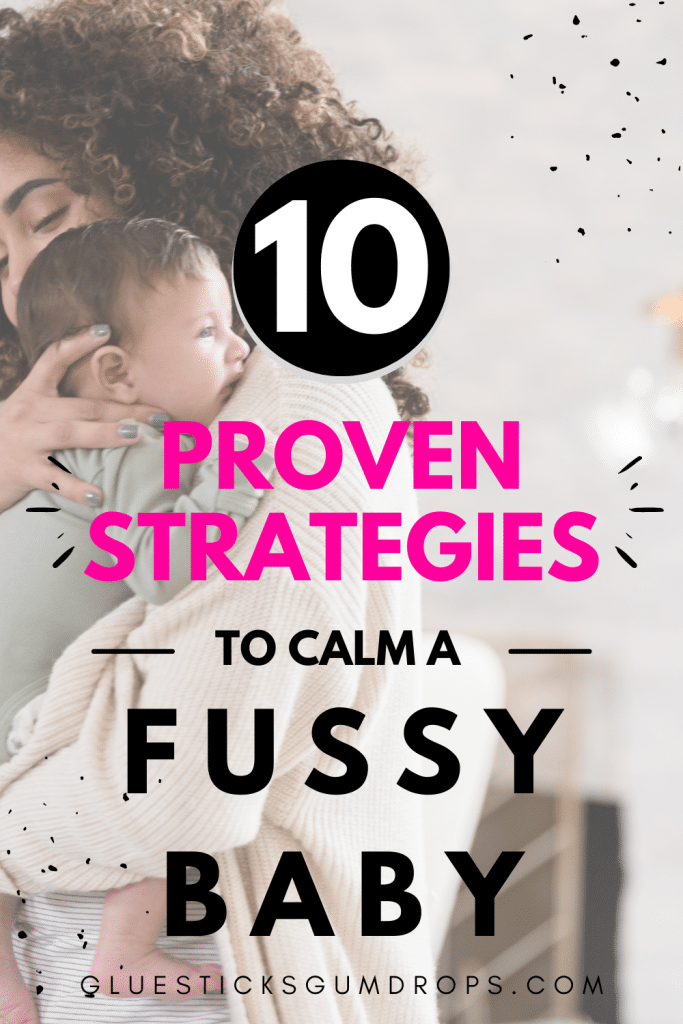Ah, the joys of parenthood—those first smiles, the tiny fingers wrapped around yours, and… the incessant crying? If you’ve ever found yourself pacing the floor at 2 a.m., desperately trying to soothe your wailing bundle of joy, you’re not alone. We’ve all been there, and let me tell you, it’s a rite of passage for new moms and dads!
Calming a fussy baby is like having a superpower. It’s not just about peace and quiet (though, let’s be honest, that’s a big plus); it’s about understanding your baby’s needs and responding effectively. A calm baby is a happy baby, and a happy baby makes for a more relaxed and confident parent.

So, how do you unlock this superpower? Don’t worry, you won’t need a cape or a secret identity—just some tried-and-true strategies that parents swear by. In this post, we’ll dive into 10 proven methods to help you turn those tears into zzz’s. Ready? Let’s get started!
The Basics: Understanding Why Babies Get Fussy
First things first, let’s talk about why babies get fussy. It’s easy to feel like you’re doing something wrong when your baby won’t stop crying, but often it’s just a normal part of infant life. Common reasons for fussiness can include:
- Hunger
- Sleepiness
- Overstimulation
- Tummy troubles (like gas or colic)
- Teething
- General discomfort (like a wet diaper or itchy clothing)

Signs of a Fussy Baby
Recognizing a fussy baby is usually pretty straightforward—they cry, right? But sometimes, the signs can be subtler. Your baby might:
- Clench their fists
- Arch their back
- Turn red or flushed
- Pull their legs up toward their tummy
- Make grunting or whining noises
It’s important to note that if your baby’s fussiness is accompanied by fever, vomiting, or other symptoms, it’s time to consult a healthcare professional. Persistent crying could also be a sign of a more serious issue that needs medical attention.
Strategy 1: Swaddling
Swaddling is like giving your baby a warm, cozy hug. It mimics the snug feeling of the womb and can be incredibly comforting for newborns. The tight wrap helps limit their startle reflex, which can wake them up or make them feel insecure.

How-To
- Lay a blanket flat: Place a square blanket on a flat surface and fold down one corner.
- Place your baby: Lay your baby on the blanket, with their head above the folded corner.
- Wrap it up: Fold one side of the blanket over your baby’s body and tuck it under the opposite arm.
- Secure the bottom: Fold the bottom corner up and over your baby’s feet.
- Finish the wrap: Bring the last corner over your baby and tuck it in securely.
Tips
- Make sure the swaddle isn’t too tight; you should be able to fit two fingers between the blanket and your baby’s chest.
- Always place your swaddled baby on their back to sleep.
- As your baby grows and starts to roll, it’s time to transition out of swaddling.
Strategy 2: White Noise
White noise works wonders because it drowns out other sounds that might be startling or distracting to your baby. It’s a steady, unchanging sound, much like what they heard in the womb.
How-To
- Choose a source: You can use a white noise machine, a fan, or even a white noise app on your phone.
- Set the volume: Keep it at a moderate level; it shouldn’t be too loud.
- Place it near the crib: But not too close—you don’t want it directly next to your baby’s ear.
Tips
- Test out different types of white noise; some babies prefer ocean waves, rain, or even the sound of a vacuum.
- Don’t rely on it 24/7; use it primarily for sleep times or particularly fussy periods.
Strategy 3: Feeding on Demand
Feeding on demand means offering the breast or bottle whenever your baby shows signs of hunger. This can be a game-changer in reducing fussiness, as a well-fed baby is generally a happier one.

How-To
- Look for cues: Open mouth, smacking lips, and turning towards the breast or bottle are all signs your baby is hungry.
- Offer the feed: Don’t wait for the crying to start; crying is a late sign of hunger.
- Let them decide: Allow your baby to eat until they’re satisfied, rather than setting a strict time limit.
Tips
- Keep track of feeding times and amounts to identify patterns.
- If you’re breastfeeding, make sure your baby is latching correctly for more efficient feeding.
- For formula-fed babies, ensure the formula is well-mixed to avoid any tummy troubles.
Strategy 4: The “5 S’s” Technique
The “5 S’s” technique, developed by Dr. Harvey Karp, is a sequence of comfort measures that mimic the baby’s experience in the womb. The 5 S’s stand for Swaddle, Side or Stomach position, Shush, Swing, and Suck.
How-To
- Swaddle: Start by swaddling your baby snugly. See above.
- Side or Stomach Position: Hold your baby on their side or stomach while you’re carrying them.
- Shush: Make a “shushing” sound close to your baby’s ear.
- Swing: Gently rock or sway your baby.
- Suck: Offer a pacifier for them to suck on.
Tips
- You may not need all 5 S’s to calm your baby; sometimes just one or two will do the trick.
- This technique is especially effective for newborns up to about three or four months old.
Strategy 5: Babywearing
Babywearing is the practice of carrying your baby in a sling or carrier. It provides the closeness and security that babies crave, and it frees up your hands to get things done around the house. Win-win!

How-To
- Choose a Carrier: Slings, wraps, and structured carriers are all good options.
- Position Your Baby: Make sure your baby is sitting in a natural, ergonomic position.
- Check for Safety: Ensure all straps and buckles are secure.
Tips
- Make sure your baby’s face is visible and they have a clear airway.
- Start with short periods and gradually increase as you both get comfortable.
- Babywearing is also a great way for dads to bond with the baby!
Strategy 6: Warm Bath
A warm bath can work like magic to soothe a fussy baby. The warm water is reminiscent of the womb and can relax tense muscles and even relieve minor aches and pains.
How-To
- Prepare the Bath: Fill a baby tub with warm water, checking the temperature with your wrist to make sure it’s not too hot.
- Add Baby: Gently lower your baby into the water, supporting their head and neck.
- Engage and Rinse: Use this time to engage with your baby, gently splashing water on their belly and limbs.
Tips
- Consider adding a couple of drops of lavender oil for extra relaxation (but always check with your pediatrician first) or use a lavender-scented body wash.
- Make sure the room is warm to keep your baby comfortable when they get out of the bath.
- Have a soft, warm towel ready for a quick wrap-up to keep the relaxation going.
Strategy 7: Pacifiers
Ah, the humble pacifier—a small but mighty tool in the quest for baby calmness. Sucking is a natural reflex for babies and can provide instant comfort. However, pacifiers are a bit of a hot topic, so it’s good to know when and how to use them.
How-To
- Introduce the Pacifier: Wait until breastfeeding is well-established if you’re nursing, usually around 3-4 weeks old.
- Offer, Don’t Force: Present the pacifier to your baby, but if they refuse, don’t force it.
- Timing: Use it for calming your baby and during sleep times, but try to avoid using it all day long.
Tips
- Opt for a one-piece, dishwasher-safe pacifier for easy cleaning.
- Always check for wear and tear; a broken pacifier can be a choking hazard.
- If your baby isn’t interested, don’t sweat it. Not all babies take to pacifiers, and that’s okay!
Strategy 8: Rocking and Holding
Sometimes, all a baby needs is to feel the loving arms of a parent. The motion of rocking and the warmth of being held can be incredibly soothing.

How-To
- Find a Comfortable Chair: A rocking chair or glider can be your best friend.
- Hold Your Baby Close: Keep your baby’s head on your chest so they can hear your heartbeat.
- Rock or Sway: Use gentle, rhythmic movements to calm your baby.
Tips
- Try different positions; some babies prefer being held upright, while others like the cradle hold.
- If your arms need a break, baby swings are a great alternative, but always supervise your baby while they’re in the swing.
- Combine this with other strategies like humming or singing for added comfort.
Strategy 9: Singing and Talking
Never underestimate the power of your voice! For your baby, it’s one of the most comforting sounds in the world. Singing lullabies or simply talking can be incredibly calming.

How-To
- Choose Your Tunes: Lullabies, nursery rhymes, or even your favorite songs can work.
- Talk It Out: If singing isn’t your thing, simply talking to your baby in a soothing voice can also work wonders.
- Make Eye Contact: This helps your baby focus and feel connected.
Tips
- You don’t have to be a Grammy-winning artist; your baby loves your voice just the way it is!
- Try whispering; the change in volume can be intriguing and calming for your baby.
- Make this a nightly routine to help your baby understand that it’s time to wind down.
Strategy 10: Consult a Pediatrician
While all the strategies mentioned are fantastic for general fussiness, there are times when it’s crucial to consult a professional. Persistent crying or fussiness can sometimes be a sign of an underlying issue that needs medical attention.
How-To
- Document the Behavior: Keep a log of when the fussiness occurs, how long it lasts, and any other symptoms.
- Prepare for the Visit: Make a list of questions or concerns you have.
- Be Open and Honest: Share all your observations and concerns with the pediatrician to get the most accurate advice.
Tips
- Always trust your instincts; you know your baby best.
- Don’t hesitate to seek a second opinion if you’re not satisfied with the advice given.
- Follow the pediatrician’s guidance and treatment plan, and schedule follow-up visits as needed.

So, what’s worked for you? Do you have a go-to strategy for calming a fussy baby that wasn’t mentioned here? Share your wisdom with us. We’re all in this parenting journey together, and your insights could be the game-changer for another struggling parent.
Additional Resources
- Books:
- “Happiest Baby on the Block” by Dr. Harvey Karp
- “The Baby Whisperer Solves All Your Problems” by Tracy Hogg
- Apps:
- Baby Sleep Sounds
- MyMedela Breastfeeding Companion
- Websites:
- KellyMom for breastfeeding advice
- American Academy of Pediatrics for trusted medical advice
- Products:
- White noise machines like the Hatch Rest
- Ergonomic baby carriers from brands like Ergobaby and BabyBjörn
